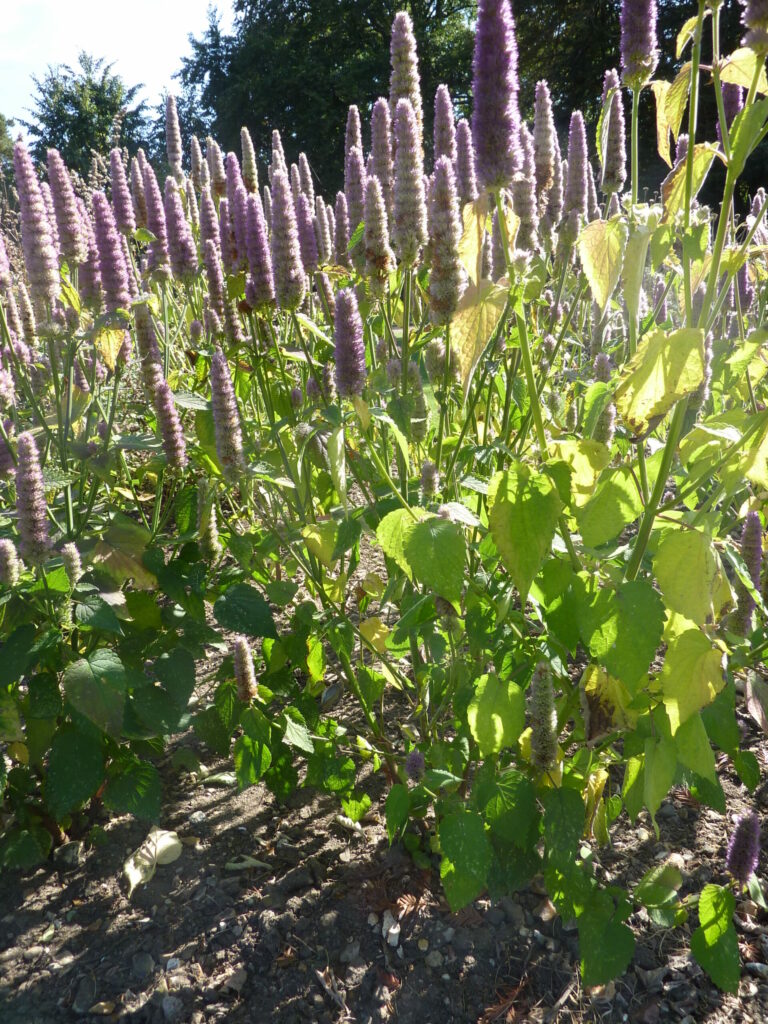Anise Hyssop
Latin Name:
Agastache foeniculum
Common Names:
Blue Giant Hyssop, Anise Hyssop, Fragrant Giant Hyssop
General Information:
Anise Hyssop is known for it’s pleasant aroma, resembling a combination of anise and mint, and attracts various pollinators, including bees and butterflies. It is a perennial herb native to North America and belongs to the mint family (Lamiacea) with a long history of use in traditional medicine and culinary practices. In folklore, Anise Hyssop is associated with protection, purification, and attracting positive energy.
When researching the plant it is important to make a distinction between Anise Hyssop and Hyssop which are two different plants.

Cultivation & Foraging:
Identification:
Anise Hyssop is a tall, upright plant that can reach a height of 2 to 4 feet (60 to 120 cm). It has square stems with opposite leaves that are lance-shaped and toothed along the edges. The flowers of Anise Hyssop are arranged in dense spikes and come in shades of purple, blue, or occasionally pink.
Anise Hyssop can be found growing in dry to moist prairies, meadows, and open woods across North America
Ecological Benefits:
Anise Hyssop is a valuable plant for pollinators, attracting bees, butterflies, and other beneficial insects to the garden. It is also used in ecological restoration efforts, as it can help improve soil health and prevent erosion.
Anise Hyssop’s nectar-rich flowers provide a source of food for pollinators during the blooming season, contributing to the conservation of these important species.
Planting:
Anise Hyssop can be propagated from seeds or by dividing established plants. Sow seeds in spring after the last frost or in late fall. Surface sow or lightly cover the seeds with soil.
Special Growing Conditions:
Anise Hyssop generally does not have significant challenges in cultivation. It prefers well-drained soil and full sun but can tolerate some shade.
Germination Time:
Seeds usually germinate within 2 to 3 weeks.
Pests & Disease:
Anise Hyssop is relatively resistant to pests and diseases. However, occasional issues may arise with aphids or powdery mildew.
Companion Plants:
Anise Hyssop is compatible with many garden plants, including other pollinator-friendly flowers like coneflowers, bee balm, and lavender.
Harvest & Culinary Use:
Parts to Harvest:
Leaves and flowers are the primary parts used for culinary and medicinal purposes.
Harvesting Time:
Leaves can be harvested throughout the growing season, and flowers are best harvested when fully open.
Preservation:
Leaves and flowers can be dried for later use. Store them in a cool, dark place in airtight containers to maintain their quality.
Culinary Use
Anise Hyssop flowers can be added to salads or used as a garnish to add color and flavor. It has a sweet, licorice-like flavor that enhances both savory and sweet dishes. Anise Hyssop leaves can be used fresh or dried in teas, salads, herbal infusions, and as a seasoning for culinary preparations.
Medicinal Use:
Digestive benefits:
Anise Hyssop has been traditionally used to promote digestion and alleviate digestive issues. However, there is limited scientific research specifically investigating its effects on digestion.
Anti-inflammatory effects:
Some studies have investigated the antiinflammatory potential of Anise Hyssop. In a study published in the Journal of Agricultural and Food Chemistry in 2014, researchers found that Anise Hyssop extracts inhibited the production of pro-inflammatory compounds in immune cells.
Anise Hyssop has been used by Native American tribes for its medicinal properties, often as a digestive aid and for treating respiratory conditions.
Antimicrobial properties:
Several studies have suggested that Anise Hyssop exhibits antimicrobial activity against various pathogens. For example, research published in the Journal of Ethnopharmacology in 2009 found that Anise Hyssop extracts demonstrated antimicrobial effects against both gram-positive and gram-negative bacteria.
Antioxidant activity:
Anise Hyssop contains compounds with antioxidant properties, such as flavonoids and phenolic acids. These antioxidants may help protect against oxidative stress and potentially reduce the risk of chronic diseases. A study published in the Journal of Agricultural and Food Chemistry in 2003 reported the antioxidant activity of Anise Hyssop extracts.
Aromatic and relaxing properties:
Anise Hyssop has a pleasant aroma and is sometimes used for its calming and soothing effects. It is occasionally included in herbal teas and natural remedies for relaxation.
Medicinal Preparation
The leaves and flowers can be prepared as teas, infusions, tinctures, or extracts for internal use.
Dosage:
Unknown
Dangers:
Anise Hyssop is generally considered safe for culinary and medicinal use when used in moderation. Like with any plant, sensitivities or allergies may occur and you should discontinue use if any adverse reactions are experienced.
Disclaimer
The information provided on this website regarding the growing, harvesting, preparation, and consumption of plants is for general informational purposes only. It is not intended to be a substitute for professional advice, diagnosis, or treatment. Always seek the advice of a qualified expert or professional before engaging in any activities related to plants. The website owner and authors make no representations or warranties of any kind, express or implied, about the completeness, accuracy, reliability, suitability, or availability of the information contained on this website. Any reliance you place on such information is strictly at your own risk. The website owner and authors disclaim any liability for any errors or omissions in the content of this website. In no event shall they be liable for any special, direct, indirect, consequential, or incidental damages or any damages whatsoever, whether in an action of contract, negligence, or other tort, arising out of or in connection with the use of the information provided on this website. The website may include links to external websites that are not controlled or maintained by the website owner or authors. The inclusion of any external links does not necessarily imply a recommendation or endorsement of the views expressed within them. The information presented on this website may not be applicable or accurate in all jurisdictions. It is your responsibility to comply with all applicable laws and regulations regarding the growing, harvesting, preparation, and consumption of plants in your jurisdiction. By using this website, you agree to indemnify, defend, and hold harmless the website owner and authors from any claims, damages, liabilities, costs, or expenses arising out of your use of the information provided on this website. This legal disclaimer is subject to change without notice, and any changes will be effective immediately upon posting.
